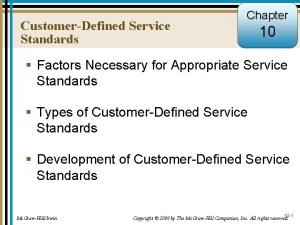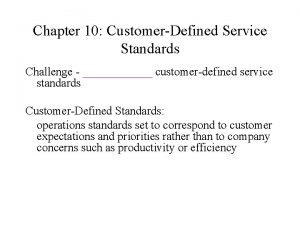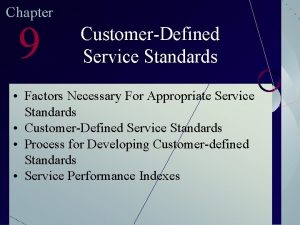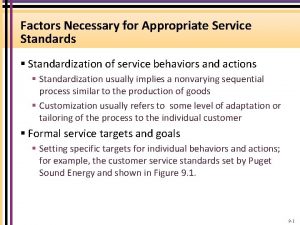Chapter 10 CUSTOMERDEFINED SERVICE STANDARDS Factors for Appropriate







- Slides: 7

Chapter 10 CUSTOMER-DEFINED SERVICE STANDARDS

Factors for Appropriate Service Standards �Standardization of Service Behaviours and Actions Personal contact instead of technology Improvements in work methods Combination of the two above methods. �Formal Service Targets How long does it take to settle customer complaints? How frequent does service fail? �Customer – not Company Defined Standards. Customers set the norm for the standards.

Types of Customer Defined Service Standards �Hard Customer-Defined Standards Something that can be measured – i. e. , we will ship it to you in two days guaranteed! �Soft Customer-Defined Standards Provide direction, guidance, and feedback to employees to achieve customer satisfaction. Can be collected by talking to customers and other stakeholders such as employees and suppliers �One-Time Fixes “technology, policy, or procedure changes that, when instituted, address customer requirements”

Hard and Soft Customer-Defined Standards – Table 10. 1, page 257

Development of Customer-Defined Service Standards � Basing standards on the service encounter sequence Using a blueprint can help Where should the focus be – front end or back end? � Expressing customer requirements as specific behaviours and actions � Measuring behaviours and actions Not all behaviours/actions are measurable Sometimes are broken down into hard and soft measurements � Adapting standards globally or locally SERVICE acronym (p. 260) � Developing customer-defined standards Figure 10. 5 – next slide � Developing service performance indexes

Process for Setting Customer-Defined Standards Figure 10. 5 1. Identify existing or desired service encounter sequence 2. Translate customer expectations into behaviors/actions 3. Select behaviors/actions for standards 4. Set hard or soft standards Measure by audits or operating data Hard 5. Develop feedback mechanisms Soft 6. Establish measures and target levels 7. Track measures against standards 8. Provide feedback about performance to employees 9. Update target levels and measures Measure by transactionbased surveys












